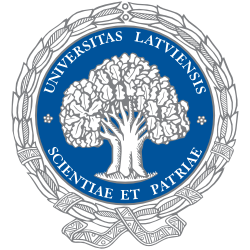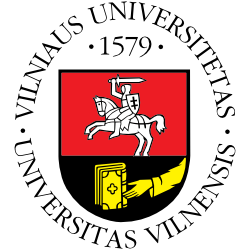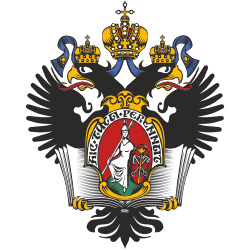- University of Latvia
- Vilnius University
- St. Petersburg State University
- Institute of Semiconductor Physics
- National Tsing Hua University
University of Latvia
Partner short name – Riga
Country – Latvia

Team leaders: M. Auzinsh (coordinator/PI), A. Ekers (co-PI)
The team is part of the Laser Centre of the University of Latvia (www.lasercentre.lv), which has a long tradition of atomic physics research. The Laser Centre is a facility with tunable single frequency laser sources established in 2005 providing dedicated research training to students and Post-Docs via state-of-the-art scientific research. The team consists from members of two groups lead by M. Auzinsh (PI) and A. Ekers (co-PI).
The Coordinator/PI (M. Auzinsh) is a very experienced research leader, who is currently serving as rector of the University of Latvia. The co-PI (A. Ekers) and two other key staff members are former Marie-Curie Fellows; they run the Marie-Curie Fellows Association’s Latvian National Group, which supports newcomer Marie Curie Fellows in practical integration matters. The co-PI was also the coordinator of the FP6 Marie-Curie Transfer of Knowledge project LAMOL (2005-2009) – a successfully completed host project that delivered 148 person months in incoming and outgoing experienced researcher visits.
Vilnius University
Partner short name – Vilnius
Country – Lithuania

Team leaders: G. Juzeliūnas (PI)
The team is the Quantum Optics group at the Institute of Theoretical Physics and Astronomy of Vilnius University (www.itpa.lt/quantumgroup/). Currently it includes 4 experienced staff members: Prof. Gediminas Juzeliūnas (PI and the Deputy director), Dr. Julius Ruseckas (permanent staff researcher), Dr. Alicija Kupliauskiene (senior staff researcher), Dr. Algirdas Mekys (postdoctoral researcher), Dr. Viačeslav Kudriašov (postdoctoral researcher), Dr. Olga Rancova (postdoctoral researcher) and V. Novičenko (master student). The research topics of the group include cold atomic gases, electromagnetically induced transparency, slow light, metamaterials and effective gauge field theories. In particular the group is working on the electromagnetically induced transparency, slowing down and storing light with orbital angular momentum in atoms, creation of artificial magnetic fields for ultracold atoms using optical means, surface polaritons and field quantisation in dielectric media and metamaterials.
The team leader Prof. Juzeliūnas is a former Humboldt Research Fellow at the University of Ulm in 1997-1998 and a Fulbright Scholar at the University of Oregon in 2000-2001. He received a National State Prize for Science of Lithuania in 2008 (together with Dr. Ruseckas). Dr. J. Ruseckas received his Ph.D. at the Institute of Theoretical Physics and Astronomy of Vilnius University in 2006, and was a Marie-Curie Fellow at the University of Kaiserslautern (2004-2005). In 2007 he got the National young scientist award for the best Ph.D. work. Dr. A. Mekys and Dr. V. Kudriašov completed their Ph.D. in 2008 at Vilnius University and just joined the group.
St. Petersburg State University
Partner short name – St. Petersburg
Country – Russia

Team leaders: N. N. Bezuglov (PI)
The team is part of the Optics Department of the Faculty of Physics of St. Petersburg State University (www.phys.spbu.ru), which was established by an outstanding Russian spectroscopist S. E. Frish. The team specialises in theoretical studies of collision processes and light-matter interactions, and provides training to students and Post-Docs within this research. The team is also known for its pioneering experiments on chemi-ionisation in 1980-ties, which play a fundamental role in plasmas, e.g., via production of seed-electrons after laser excitation that leads to full ionisation and creation of photoplasmas. The theoretical expertise ranges from quantum scattering theory to radiative and impact kinetics of laser excited gases/plasmas. The team exploits Feynman path integral techniques and multidimensional semiclassical approaches. The most important achievements of the team are: (i) involvement of the stochastic mechanics for description of the dynamics of temporary (short-lived) quasi-molecular systems; (ii) development of original analytical methods for the solution of integral kinetic equations of radiation trapping (Geometrical Quantisation Technique); (iii) elaboration of original semiclasssical schemes for solving different problems of radiative kinetics including nonlinear phenomena; (iv) innovative adjustment of “split propagation techniques” for the analysis of both a variety of energy transfer processes by means of wave-packet evolution and coherent population transfer in atomic systems. Activities in the area of applied research include work on optimization of laser isotope separation schemes and studies of negative conductivity in photo-plasmas.
Team works primarily theoretically with some experimental activity. Instrumentation and infrastructure include an effusive atomic beam, excimer and cw dye laser systems, massspectrometry, optical spectroscopy. Existing links with other teams: common publications exist with Riga and Novosibirsk teams. The team was a partner in the FP6 Marie-Curie Transfer of Knowledge project LAMOL coordinated by Riga team. St. Petersburg and Novosibirsk teams are partners in a bilateral Italian-Russian project. In 2002-2005 years St. Petersburg and Novosibirsk teams have been involved in a joint INTAS 2001-0155 project together with PI of Riga team.
Institute of Semiconductor Physics
Partner short name – Novosibirsk
Country – Russia

Team leaders: I. I. Ryabtsev (PI)
The Novosibirsk team is part of the Rzhanov Institute of Semiconductor Physics, Siberian Branch of Russian Academy of Sciences (www.isp.nsc.ru). The team has a great experience in experimental studies on nonlinear laser and microwave spectroscopy of excited states of alkali-metal atoms and on their laser cooling. Earlier they have obtained the following results: spectra of nonlinear multiphoton microwave transitions in Rydberg atoms have been investigated; a splitting of the two-photon resonance due to dynamic Stark effect and a double Stark resonance have been observed for the first time; quantum interference of the one- and two-photon photoionization channels of the 4S excited state of sodium in the field of the first and second harmonics of a Nd:YAG laser has been observed; applicability of Rydberg atoms to quantum information processing has been investigated; rate constants of thermal and collisional ionization of Rydberg atoms for collisions inside a single atomic beam and for two crossed atomic beams have been measured; influence of the finite detection efficiency of the SFI detector on the observed spectra of resonant dipole-dipole interaction of Na or Rb atoms has been studied; experimental data on the spectroscopy of cold Rb Rydberg atoms in a MOT has been obtained; resonances of electromagnetically induced transparency in a four-level Nscheme of optical transitions have been investigated; process of coherence transfer at spontaneous decay of excited states has been studied; experiments on microwave spectroscopy of cold Rb atoms in a MOT have been done and a narrow resonance due to transfer of atoms to dark states at the center of cold atom cloud has been found. Team works both experimentally and theoretically. Instrumentation and infrastructure include the experimental setups for investigation of hot Rb atoms in vapor cells and cold Rb Rydberg atoms in a MOT, which comprise of externalcavity diode lasers, Rb optical cells, electronic systems, interferometers, spectrum analyzers, Ti:Sa and dye lasers pumped by Nd:YAG lasers, vacuum chamber, optical and mounting elements, microwave oscillators, and data acquisition systems. Existing links with other teams: common publications exist with St. Petersburg and Riga. The Novosibirsk team has been involved in a joint INTAS 2001-0155 project with St. Petersburg and Riga teams. Riga team has been hosting an INTAS Young Scientist Fellow from Novosibirsk in 2005 and 2006.
National Tsing Hua University
Partner short name – Hsinchu
Country – Taiwan


Team leaders: I. A. Yu (PI), Y. C. Chen (Co-PI), Y. F. Chen (Co-PI)
The team is led by Prof. Ite A. Yu (atomcool.phys.nthu.edu.tw) and is one of the leading groups in the experimental studies of slow light and storage of light with laser-cooled atoms in the world. There are five major progresses in the recent years. (i) The team proposed and experimentally demonstrated a new scheme of lowlight-level XPM based on the light-storage technique. The new scheme enhances the flexibility of the experiment and makes possible conditional phase shifts of the order of π with single photons. One can utilize the single-photon XPM in the applications of quantum nondemolition measurements, quantum phase gates, and the manipulation of quantum information. (ii) The team experimentally demonstrated the all-optical switching in which a single-photon pulse switched by another is feasible. This light-storage all-optical switching can be a very useful tool in the manipulation of quantum information. (iii) The team reported the first demonstration of manipulating the retrieved width, frequency, and polarization of stored light pulses. This method can bridge different quantum devices, each of which only interacts with light of specific properties. (iv) The team successfully achieved Bose-Einstein condensation (BEC) of 87Rb atoms. The transition temperature is around 250 nK at a density of well above 10^13 cm^-3. Well below the transition temperature, we obtain 5×10^4 atoms in the pure Bose condensate. Accurate and robust method for the direct measurement the atom number in a Bose condensate was also demonstrated. This method of optical pumping will be a very useful tool in the BEC studies, as the mean-field energy is directly proportional to the atom number and plays a very important role in the properties and dynamics of a Bose condensate. (v) Utilizing a cigar-shaped cold atom cloud with an optical density of about 40, the team successfully produced stationary light pulses (SLPs), i.e., light pulses without motion, in cold atomic media. The team’s work provides a better understanding for SLPs and opens the way to SLP studies in cold as well as in stationary atoms. The SLP greatly enhances the interaction time between photons and atoms, offering new possibilities for low-lightlevel nonlinear optics and manipulation of photonic information.